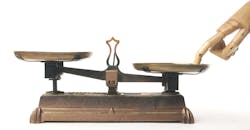Last month’s column discussed the potential downsides of manipulating interest rates. This month’s will review another issue that has been debated recently—namely, currency manipulation.
China has been undervaluing its currency for the last three decades. What has been the impact of this strategy?
First, it set the foundation for the initial jumpstarting of the Chinese manufacturing economy by making China’s products less expensive to the rest of the world. Second, it supported China’s otherwise unsustainable economic growth. Finally, it has attempted to dampen the impact of U.S. tariffs on Chinese products.
In the first two instances, this strategy has proved very effective. Time will tell relative to the third.
The issue at hand, then, is: Should the United States play tit-for-tat and reduce the value of its dollar to counter the recent (and possibly future) yuan devaluations?
An example can perhaps best shed light on this question.
At one point in my career, I was responsible for the purchase of something referred to as Outside Purchased Products (OPP). This was not MRO (maintenance, repair and operations) type material. Rather, it was product already in production at another manufacturer that my company would have them customize to our product image requirements, then purchase and sell as our own product.
You may wonder why this would be done. In our case the answer was simple. The demand for the products in question wasn’t strong enough to justify the investment that would have been needed to set up our production of them. Yet these products were needed to complement and supplement our existing product line.
Some of the OPP my people purchased were produced in Europe. This was in the early 2000s, when the euro had just been adopted as the common European currency. My company’s preference was always to purchase products in U.S dollars, as our country’s currency was considered the most stable in the world and its consistent value could be counted on. Thus, our contracts with the European OPP supplier were in U.S. currency. So what’s the issue? Don’t companies assume currency risks when they trade internationally?
In the early years of the euro, the Bush administration adopted a policy of devaluing our dollar in order to increase this country’s exports. Sound familiar? In doing this we were, in fact, adopting the Chinese government strategy of devaluing the yuan to spur their country’s exports. Combined with other market forces, this conscious currency devaluation led to an overall devaluation of the U.S. dollar versus the euro by about 20%.
Since our contract and payments were in U.S. dollars you might conclude that my company was now getting a really good deal. Unfortunately, it turned out to be too good of a deal. Our European-based OPP suppliers refused to honor their contracts, saying that to do so would put them out of business. We, of course, didn’t want that, so I went over to Europe tried to try to work out an acceptable solution.
On a personal note, one of the people I had to meet with was the owner of a medium-sized Bavarian company, a man named Dieter. He was 6 foot 8 inches tall and probably weighed about 350 pounds, most of it muscle. Dieter didn’t smile very much during the negotiations and, to say the least, the initial discussion was very uncomfortable.
Paul Ericksen's columns are part of IndustryWeek's Supply Chain Initiative.
You may wonder how we supported my employer’s interests and yet at the same time satisfied European owners such as Dieter. First, we accepted that we would have to pay additional U.S. dollars for their product since it had been a deliberate decision by the U.S. government to devalue its currency. Second, we came to a sharing agreement that would help keep our OPP suppliers profitable.
Another personal aside: after the conclusion of our negotiations, Dieter took me out to a “bierstube” to celebrate our new arrangement, and I can say that although I have a reputation of being able to raise a stein or two, I certainly couldn’t keep up with Dieter.
This agreement, however, didn’t resolve all the issues related to the impact of currency manipulation. The OPP we purchased from Europe was primarily sold in the U.S. market. The result of the negotiated settlement was that my company had to raise its prices to maintain its profitability since we were paying more for those products. The overall impact was that our sales went down and we consequently purchased fewer OPP units from our European sources.
I’ve shared this example to explain what can happen when countries start working outside of normal market forces. The resulting impacts often lead to unintended consequences. For instance, when a country reduces the value of its currency, it does so against the currencies of all countries.
So while reducing the value of U.S. currency may partially offset the tariff relief China is seeking from their recent devaluation as well as spurring our exports, it also results in imports from other countries costing more and our exports to them bringing in less real compensation. When costs go up, prices eventually have to go up, too. When consumers have to pay more for the things they buy, inflation follows. And this can initiate a death-cycle of further inflation, which further reduces the value of our currency, etc., etc. etc. The only real solution to inflation, then, is belt-tightening, which falls on the backs of U.S. consumers.
One difference between the U.S. devaluing its currency and China doing so is that China is not a democracy. They are a communist-ruled oligarchy and consequently can impose belt-tightening on their citizens. The U.S. is a democracy, and its citizens do not necessarily have to put up with policies imposed on them by their government. In other words, there will likely be a strong public backlash to inflation.
I’d like to offer an alternative to tit-for-tat currency manipulation between the U.S. and China. Instead of matching China’s devaluation of their currency, why not tie our tariffs on their goods to any manipulation they enact? In other words, if China reduces the value of their currency by 10%, our 25% tariffs on their goods should float up 10%--to 27.5%--effectively countering their move. Of course, this will cause pain to our economy but the effect will be reduced, since the price increase impacts will only be on goods we import from China.
Anyway, the above is another case where government intervention in a trade relationship is, I believe, required. But our country has to be innovative in the strategies it uses in our trade war with China to lessen the negative impacts on our economy.
Paul Ericksen is IndustryWeek’s supply chain advisor. He has 38 years of experience in industry, primarily in supply management at two large original equipment manufacturers.
About the Author

Paul Ericksen
Executive Level Consultant; IndustryWeek Supply Chain Advisor
Paul D. Ericksen has 40 years of experience in industry, primarily in supply management at two large original equipment manufacturers. At the second he was chief procurement officer. He then went on to head up a large multi-year supply chain flexibility initiative funded by the U.S. Department of Defense. He presently is an executive level consultant in both manufacturing and supply chain, counting Fortune 100 companies among his clientele. His articles on supply management issues have been published in Industrial Engineering, APICS, Purchasing Today, Target and other periodicals.
